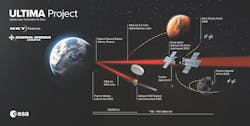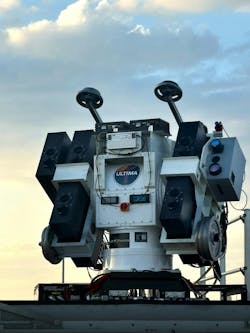NKT Photonics powers ESA's deep space laser link
Earlier this year, the European Space Agency (ESA) got a big breakthrough when they set up Europe’s first deep space optical communication link using a high-power fiber laser system from NKT Photonics.
For the first time, a radio link wasn’t used to communicate with deep space. Instead, they used laser light to communicate between Earth and NASA’s Psyche spacecraft 300 million kilometers (186 million miles) away.
This breakthrough in deep space communication is the result of collaboration between ESA, the U.S. National Aeronautics and Space Administration (NASA)/Jet Propulsion Laboratory, and a consortium of European companies, including NKT Photonics. The technology developed for this ULTIMA project (see Fig. 1) was supported by funding from ESA, which was delivered through the U.K. Space Agency’s General Support Technology Programme (GSTP).
Efficient deep space communications
Before now, communicating with distant spacecrafts was done via radio link. Lasers offer a new and more efficient way to communicate. The ground laser transmitter system emits a narrow-linewidth, modulated signal so the distant spacecraft can precisely locate the ground station and lock onto it to establish an optical link for high-speed data transmission from the spacecraft to a separate receiver ground station located nearby.
With this new kind of laser communication system, using our high-power fiber lasers, data is now being sent across the vacuum with astonishing efficiency and clarity. These laser links are more focused than radio solutions and efficiently transfer data at high rates across millions of kilometers—without the need for a large antenna or encountering the licensing restrictions that apply to radio transmission.
Power, precision, and sensitivity
To ensure successful communication with deep space, three major challenges needed to be addressed.
The first challenge was building a laser with enough power to be detected at extreme distances. The laser generates a powerful multikilowatt beam that the transceiver onboard the Psyche spacecraft can detect.
Next came developing a pointing system with the precision to aim accurately at the spacecraft millions of kilometers away. For this part of the project, NKT Photonics partnered with GA Synopta, a company based in Switzerland (a nation known for its precision).
Finally, we needed a receiver system that was sensitive enough to detect the extremely faint signals being sent back by the spacecraft and decode the data. Another consortium built this side of the system using the most advanced detectors. These detectors, called superconducting nanowire single-photon detectors, had to be cooled to 1 degree Kelvin to enable single photons to be counted.
Once all the pieces of the communications link were ready, it was time to install the system at the test site (see Fig. 2). Greece was chosen as a test location, with the transmitter located at the Kryoneri Observatory and the receiver located at the Helmos Observatory—both within the Peloponnese region.
High-power lasers ensure a robust optical link
NKT Photonics’ Koheras single-frequency fiber laser platform is the heart of the system, built around an ACOUSTIK sub-rack with seed laser, pre-amplifier, modulators, and a custom timing module. The signal is split and boosted by five high-power amplifiers, based on core technology, and each amplifier delivers up to 2 kW with less than 10 microseconds’ switching time.
The system’s precise pointing technology uses star cameras and fine-steering mirrors to pinpoint the kilowatt beams in the night sky with incredible arcsecond accuracy. This is equivalent to hitting a 1-mm target at 1-km range. The method, known as blind-pointing, is particularly challenging because it relies only on the calculated location of the spacecraft. Real-time feedback from the spacecraft was not possible because the time taken for the light to travel this vast distance and for the return telemetry to be received was approximately 30 minutes.
This type of optical link with spacecraft offers a glimpse into the future of deep space communications, including manned and unmanned missions to the Moon, Mars, and beyond, and highlights the importance of collaboration between agencies and industry in advancing Europe’s optical technology.
First-attempt success within tight test window
We had a limited window for testing. The Psyche spacecraft is on a long journey to investigate a metallic asteroid and can’t slow down simply because our equipment isn’t ready. The equipment was delivered to the installation site just four days before the first trial, so the timeline for installation and testing was extremely tight. But thanks to an incredible team effort, the optical link worked on the first attempt.
In the weeks that followed, three additional trials were carried out, each more successful than the last with higher data rates, longer distances, and more data downlinked and decoded. In the final link with the spacecraft at more than two earth-sun distances, a sustained link was obtained with a data rate of 1.8 Mbps that allowed a high-definition video of “Tatters” the cat chasing a laser pointer to be received from the spacecraft, which has been widely shared on social media.
For NKT Photonics, it’s not just about building the biggest or the fastest communication channel. It is about pushing the boundaries of what is possible with lasers and photonics. We take pride in being a technology-driven company, and this achievement is a groundbreaking milestone for us.
The laser links are proving themselves, pushing data rates far beyond what was once thought possible for deep space. The result? Spacecrafts fitted with laser links can be built smaller and lighter. Every gram of weight saved can be used for scientific instruments, exploration tools, or fuel to reach farther.
Future exploration
What’s next? More lasers for space comms? Talking to the moon or maybe even Mars? Or using lasers to locate, track, and possibly even maneuver satellites and space debris? Whatever the future brings, NKT Photonics is excited to see how this will develop over time and proud to play our part pushing the boundaries.
About the Author
Mike Yarrow
Mike Yarrow is a senior engineering manager at NKT Photonics (Southampton, U.K.).

